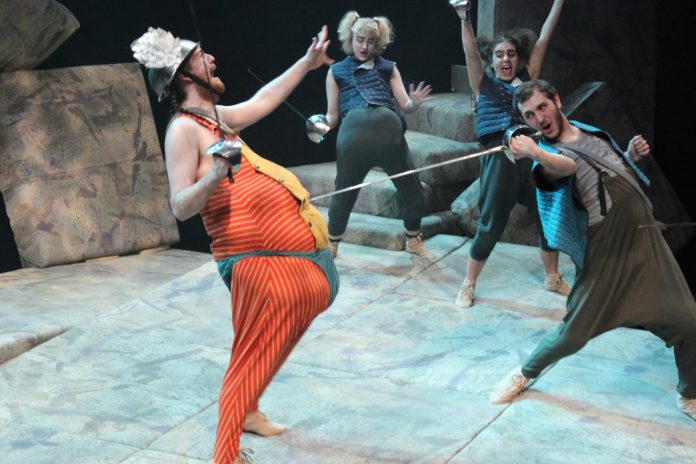There aren’t many plays in which an audience sees a colander used as a crown and a toilet plunger used as a scepter, but in Ubu Roi, that is just one of the hilariously bizarre elements of the world of the play. This past weekend, Feb. 21 to 25, the Muhlenberg Theatre and Dance Mainstage delighted audiences for six performances with director Francine Roussel’s production of this show, written originally in French by Alfred Jarry and translated by Rob Melrose.
Ubu Roi takes inspiration from Shakespeare’s Hamlet and Macbeth both in story and in language, as the characters of Mother and Father Ubu work with Captain Bordure to gain control and crown Father Ubu king of Poland. The play begins in a rather absurd and nonsensical manner at first, but as the play progresses, Father Ubu becomes hungry with power, murdering anyone who works against him. As the plot thickens, the events of the play become more serious, but they are still filled with hilarious moments.
The cast was led by Gabrielle Adamo ’18 as Mother Ubu and David Raccio ’18 as Father Ubu, who began the play with a scene full of fantastically executed outrageous humor and excellent chemistry. Their opening scene immediately pulled the audience to the absurd atmosphere of Ubu Roi. Adamo and Raccio acted with each other extremely well; both of them were unafraid to be outrageous and absurd, which helped establish their characters and the tone of the performance. Each actor was superb, but some of the highlights included Caden Fraser ’20 as the meek King Wenceslas, who had impressive physicality and comedic timing, and Evan Plaza ’19 as the revolutionary Bougrelas, whose delivery and stage presence helped him completely embody his character.
One element of Ubu Roi that was particularly impressive was that, except for Adamo and Raccio, every actor played multiple roles in the production. Mike Poyntz ’18 was one of these actors, playing Captain Bordure, Second Horse, The Bear, The Commandant and several ensemble roles. He spoke about the process of playing more than one character in the show and preparing to accomplish such a task, explaining that “it was definitely difficult for the ensemble to play different roles throughout the show.” Poyntz also added that “focusing on the physicality of the characters was a priority.”
The performances of the cast members of the ensemble were particularly effective. Each of the actors did an excellent job of portraying each of their ensemble roles and distinguishing them from each other. The energy of every member of the ensemble was impeccable, and the group kept up its energy and enthusiasm during both the exaggerated moments of humor and the action-heavy fight scenes. The rehearsals for Ubu Roi seemed to explore this hilarious and outrageous atmosphere. As Adamo explains: “Francine really encouraged us to be bold and make strong choices, and that’s how we found a lot of the comedic moments in the show.”
The ensemble stood out to audience members as well, with Cate Esposito ’21 praising the actors for “moving together in harmony, and coming together as a perfect ensemble.” The performances by the ensemble were enhanced even further by Michael Chin’s fight choreography. It was compelling to watch and added a great rhythm to all of the fight scenes, as well as often contributing humorous moments to the production.
All of the technical elements of the production were also excellent. The scenic and lighting design, done by Curtis Dretsch, Director of Design & Technical Theatre, added to the almost barbaric nature of the characters through the imitation of stone in the design of the cubes that made up the set. The narrative was not hindered by the lack of set changes. The show’s easy flow existed both because elements of the locations of several scenes were incorporated into the set and emphasized only when necessary, such as the ropes on the ship and the mouth of the cave, and because each location was displayed on a sign before each scene by Jacob Wahba ’20. Furthermore, Dretsch’s lighting design used primarily earthy colors, but during the major battle at the end of the play, the lights switched to bright primary colors that lined up with the squares on the floor of the set, creating the appearance of a checkerboard. This was a unique quality that added to the chaos of the battle scene.
Although Ubu Roi is absurd in nature, many of the messages in the play have a surprising amount of relevance to today’s world and political climate. Adamo described how “Ubu Roi starts conversations about the current political climate we are in without making overt statements about people in power. Instead, it shows people of all political affiliations the destruction that happens when we let people like Mama Ubu and Papa Ubu step into positions of power.” Ubu Roi mixes comedy and absurdism with a surprisingly poignant political statement to make an experience that all audience members can enjoy.
Additionally, despite suffering a concussion, Sophia Happonen ’21 was still included in the show as the Voice of The Shadow and in the final number for the show. Poyntz said that “all of the cast loves her so much, and we were all very upset that she couldn’t be up there in the scenes with us.” Happonen’s appearances in the show reflect not only her dedication, but also the bond between the members of the cast.
Muhlenberg’s production of Ubu Roi was full of outstanding performances and technical elements that kept audience members engaged and entertained throughout. Viewers at each of the performances enjoyed the show, even, as Jillian Edmundson ’21 added, wishing they “had an opportunity to see it again.”
As Poyntz described, Ubu Roi is “funny, thought-provoking, and disgusting. It’s relevant and unlike any play you’ll ever see.” He couldn’t be more correct. Every element of the production blended together fantastically well to create a show that will certainly be one to remember.






















